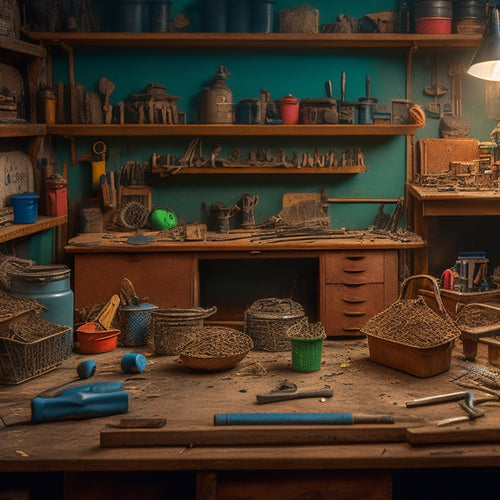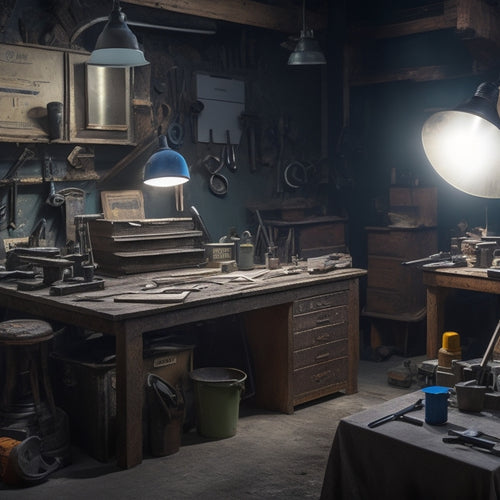
5 DIY Tool Must-Haves for Exterior Renovation
Share
When tackling an exterior renovation, you'll want to prioritize safety and efficiency by having the right tools on hand. First, invest in essential safety gear like protective eyewear, durable gloves, and a respirator to protect yourself from hazardous materials. Next, measure and mark your project accurately with a 25-foot tape measure, level, and brightly colored marking chalk. Prepare surfaces with a wire brush, power washer, and scraper, and then apply materials using a V-notched trowel and finishing trowel. Finally, finish and clean up with a steel taping knife, putty knife, and vacuum cleaner - and you'll be well on your way to a successful renovation, with even more expert tips and tricks waiting to be discovered.
Key Takeaways
• Protective eyewear and gloves are essential for safeguarding against flying debris and harsh materials during exterior renovation.
• A reliable measuring tape and level ensure accurate distance measurements and plumb surfaces for a professional finish.
• A power washer is a must-have for effectively cleaning exterior surfaces by blasting away grime and old adhesives.
• A putty knife and finishing trowel are crucial for filling gaps and smoothing out materials to achieve a seamless finish.
• A vacuum cleaner and soft-bristle brush help maintain a clean workspace and remove debris for a successful exterior renovation.
Essential Safety Gear for Stucco
When working with stucco, you'll need to wear essential safety gear to protect yourself from the hazards of flying debris, caustic alkalinity, and respiratory threats. Don't become a DIY disaster story - gear up!
Protective eyewear is a must, as stucco can be notoriously pesky when it comes to getting in your eyes. You don't want to be stuck with a face full of gritty mix, trust us. Invest in a good pair that provides solid coverage and won't fog up on you mid-project.
Next, slip on some durable gloves to shield your hands from the harsh alkalinity of stucco. You'll be grateful for the extra layer of protection when you're scrubbing away at a stubborn patch of old stucco. And, let's be real, you'll also appreciate not having to deal with the aftermath of acid-burned skin.
With these essentials in place, you'll be ready to tackle your stucco project with confidence and caution.
Measuring and Marking Tools Needed
With your safety gear in place, you'll turn your attention to the precise measurements and markings that'll confirm a successful stucco renovation. Measuring and marking tools are essential for guaranteeing accuracy and avoiding costly mistakes. Here are the must-haves:
| Tool | Description | Purpose |
|---|---|---|
| Measuring Tapes | 25-foot or 33-foot fiberglass or cloth tapes | Measure distances, widths, and heights |
| Marking Chalk | Brightly colored, water-soluble chalk | Mark lines, patterns, and boundaries |
| Level | Torpedo or box level | Verify surfaces are level and plumb |
| Straightedge | 6-foot or 8-foot aluminum or fiberglass straightedge | Draw straight lines and edges |
| Calculator | Construction calculator or smartphone app | Calculate complex measurements and quantities |
When choosing measuring tapes, consider the length and material (fiberglass or cloth) that suits your project needs. Marking chalk is a must for creating temporary lines and patterns on your stucco surface. A level verifies your renovation is, well, level and plumb, while a straightedge helps you draw accurate lines. Finally, a calculator saves you from mental math gymnastics and reduces errors. With these measuring and marking tools, you'll be well on your way to a successful stucco renovation.
Surface Preparation Tools Required
You'll need to prep the stucco surface to guarantee a strong bond between the old and new materials, and that requires a set of specialized tools.
Don't skip this step, or you'll end up with a renovation that looks like it was done by a DIY disaster. To secure a strong foundation, you'll need the right surface preparation tools.
Here are the must-haves:
-
Wire brush: For removing loose debris and dirt, a wire brush is your best friend. It's like a mini-vacation for your stucco surface.
-
Power washer: Time to get down and dirty with some serious surface cleaning techniques. A power washer will blast away dirt, grime, and old adhesives.
-
Scraper: This tool is perfect for removing old, flaking stucco and creating a smooth surface for new materials. Think of it as a mini-surgery for your stucco.
- Moisture meter: This handy tool helps you evaluate the substrate's moisture levels, ensuring you're not applying new materials to a damp surface. It's like having a built-in warning system for potential water damage.
Application and Smoothing Tools
Now that your stucco surface is prepped and ready, it's time to apply new materials and smooth out the finish, requiring a different set of tools that'll help you achieve a professional-looking result.
For application, you'll need a variety of trowels, including a V-notched trowel for applying stucco, a finishing trowel for smoothing, and a putty knife for filling gaps. Mastering trowel techniques, such as holding the trowel at a 45-degree angle and using long, sweeping strokes, will guarantee an even application.
Next, it's time to smooth out the finish using specialized smoothing strategies. A float, a long-handled tool with a flat, rectangular blade, is perfect for removing excess material and creating a smooth surface. A darby, a long, flat tool with a handle, helps to flatten and smooth out the surface, removing any air pockets or bubbles.
Don't forget to have a bucket of water and a sponge on hand to clean your tools and remove excess material as you work.
With these application and smoothing tools in your arsenal, you'll be well on your way to achieving a flawless exterior renovation.
Finishing Touches and Cleanup
Five essential tools remain to complete the exterior renovation: a steel taping knife, a putty knife, a scrub brush, a soft-bristle brush, and a vacuum cleaner. With these tools, you'll be able to put the finishing touches on your project and get ready for the final inspection.
Here are the tasks you'll use each tool for:
-
Steel taping knife: Scrape off excess compound and smooth out joints.
-
Putty knife: Apply and smooth out caulk and sealants.
-
Scrub brush: Clean away dirt and debris from surfaces.
- Soft-bristle brush: Dust off surfaces before applying finishing coats.
Remember to stock up on cleaning supplies, like rags, solvents, and soap, to get the job done efficiently.
As you work through these final tasks, keep in mind that a clean workspace is essential for a successful renovation. Take your time, and don't rush through the finishing touches – it's the last step before you can stand back and admire your hard work!
Frequently Asked Questions
Can I Reuse Tools From Previous Interior Renovation Projects?
You're wondering if you can reuse tools from previous interior renovation projects? Well, it's not a one-size-fits-all answer.
You need to assess the tool condition - are they still in top shape or have they seen better days?
Also, consider project compatibility - will the tools be suitable for the exterior renovation tasks at hand?
If the answers are yes, go ahead and reuse them.
But if not, it's better to invest in new ones to avoid frustrating setbacks and potential safety hazards.
How Often Should I Sharpen or Replace Worn-Out Tool Blades?
You're wondering how often to sharpen or replace those worn-out tool blades, huh? Well, let's get down to business!
Regular blade maintenance is key to tool longevity. Check your blades daily for signs of wear, like dullness or chipping.
Sharpen them every 1-3 months, depending on usage. If they're beyond repair, replace them to avoid damaging your tools or, worse, yourself.
Stay on top of it, and your tools will stay sharp – literally!
Are There Any Eco-Friendly Alternatives to Traditional Renovation Tools?
As you wield your trusty hammer, remember the weight of your impact on the environment.
You're not just building a deck, you're building a legacy.
Luckily, you can swap your carbon footprint for a green thumb with eco-friendly alternatives.
Look for tools made from sustainable materials, like reclaimed wood or recycled metal.
Energy-efficient tools, powered by lithium-ion batteries or solar panels, will also reduce your ecological impact.
Make the switch and hammer out a greener future!
Can I Borrow Tools From Friends or Rent Them Instead of Buying?
You're a savvy DIYer, always looking for ways to save a buck! Instead of breaking the bank on tools, you're wondering if you can borrow from friends or rent instead of buying.
Tool sharing and rental options are definitely viable, and they can help reduce waste and your carbon footprint.
Just make sure to inspect the tools before taking them, and don't be afraid to ask your friends about their tool's history - you don't want any surprises mid-project!
How Do I Properly Store and Organize Tools After the Project?
'A place for everything, and everything in its place' - that's the mantra to live by when it comes to tool storage.
You've worked hard to accumulate the right tools; now it's time to keep them organized.
Invest in a sturdy tool chest or cabinet with dividers to keep similar tools together.
Label each compartment so you can find what you need in a snap.
Implement an organization system that works for you, like categorizing tools by project type or frequency of use.
Conclusion
You've made it to the final stretch of your exterior renovation project!
With these 5 DIY tool must-haves, you've conquered the stucco jungle and emerged victorious.
You've got the skills, the know-how, and the arsenal to tackle even the most challenging exterior renovation tasks.
You're a master builder, a stucco superhero, capable of transforming any exterior into a work of art!
Now, go forth and renovate like the wind - your exterior renovation game is unstoppable!
Related Posts
-

Why Tool Exchange Matters in Home Renovation
You rely on a well-maintained tool belt to complete home renovation projects efficiently, and having access to the ri...
-

Top 3 Insurance Options for Home Renovation
When renovating your home, you need specialized insurance coverage to protect your finances from unexpected setbacks ...
-

What to Inspect When Buying Used Renovation Tools
When buying used renovation tools, you need to scrutinize every detail to avoid costly mistakes. Inspect for rust and...


